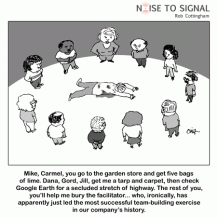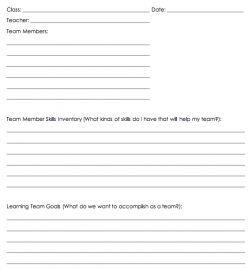Collaborative Learning: An Innovative Educational Approach
As the goal of educators is becoming increasingly focused on preparing students for future success in a vocational goal oriented society, and through an unstructured approach, the success of Collaborative Learning lay grounded on the foundation. Collaborative Learning is a process that can be applied to any academic discipline and used by learners of any age.
Explore the highlights of Collaborative Learning, as presented by this section's authors Will Dressler, Lisa McDown and Cheryl Matthews.
What is Collaborative Learning?

An interactive approach to teamwork that enables the learner to combine their individual skills and resources to generate creative solutions to mutually defined problems.
It is an educational approach that involves a joint effort by learners and/or instructors together. Learners work in groups of two or more, mutually looking to reach the same understanding, solution, meaning or creation of a product. Most collaborations involve learner exploration. Rather than an instructor-centered delivery of information, the learner is expected to apply knowledge as evidence of understanding.
Collaborative Learning differs from Cooperative Learning in that collaborative learning involves learners working together while the instructor does not always have a pre-set notion of the problem or solution learners will be researching. While in cooperative learning each learner is responsbile for a portion of the work while the instructor has a pre-set notion of the problem or solution the learners will be researching.
Collaborative Learning is: Student Centered, Groups of Learners Working Together, a Social Activity, Role of Instructor Switches to "Coach", Increases Responsiblitiy to Learner
Benefits and Challenges of Collaborative Learning

Benefits of Collaborative Learning:
When two necessary key elements (group goals and individual accountability) are used together, the effects of collaborative learning on achievement are consistently positive. It also benefits students through improved relations among different ethnic groups and students with learning disabilities. Other benefits include:
1. Development of higher level thinking skills creates an environment of active, involved, exploratory learning
2. Students explore alternate problem solutions in a safe environment
3. Addresses learning style differences among students
4. Classroom resembles real life social and employment situations
Challenges of Collaborative Learning: There are challenges with the implementation of collaborative learning approaches:
For instructors:
Extensive revision of syllabus to account for increase in group work. Revision of time allocation for assignments. Adaptation to changing role that includes increased student responsibility for own learning.
For learners:
Adjustment to group work format. Time management issues involved with working around group members’ schedules. Increased responsibility for own learning. Classrooms set-up for teacher-centered/lectures. Conversion from competitive to cooperative nature.
One huge obstacle is the way cooperative learning is viewed by administration. The following scenario is all too common:
“Oh, you’re doing groups today. I’ll come back when you’re teaching.”
Tools to Enhance Collaborative Learning
These are just a few of the online tools available to assist the instructor with the delivery of Collaborative Learning.

Del.icio.us allows you to keep links to your favorite articles, blogs, music, restaurant reviews, and more. You can access these links from any computer on the web. Share favorites with friends, family, and colleagues. Discover new things. Everything on del.icio.us is someone's favorite - they have already done the work of finding it...explore and enjoy!

Elluminate provides proven, best-in-class solutions for real-time online learning and collaboration that deliver exceptional outcomes, including enhanced learning experiences, increased retention and completion rates, and higher ROI. Elluminate has served more than 300 million web-collaboration minutes to over 3 million teachers and students located in 185 different countries.

Google Docs & Spreadsheets allows the user to create basic documents and spreadsheets from scratch. You can easily do all the basics, including making bulleted lists, sorting by columns, adding tables, images, comments, formulas, changing fonts, upload existing files and more. And it is free! Google Docs & Spreadsheets accepts most popular file formats, including DOC, XLS, ODT, ODS, RTF, SCV, etc. So go ahead and upload your existing files; all your formatting and formulas will come through intact. And because it is on the Web, your documents are always accessible by you and your team. Powerpoint, Excel, Word, sites.

Second Life is a free online virtual world imagined and created by its residents. From the moment you enter Second Life, you will discover a fast-growing digital world filled with people, entertainment, experiences and opportunity.

Skype aims to delight you by offering free global telephony, to make unlimited, superior quality voice calls via its next-generation peer-to-peer software. Skype's mission is providing a simple, reliable and friendly communications tool that just works. Aiming for people to communicate with friends, families, and colleagues more flexibly, more cost-effectively, and with better sound quality than ever previously imagined.
Developing a Team Charter

A key element of collaborative learning is teamwork. In order to develop an effective team, members must be aligned in defining their purpose, identifying potential obstacles, creating boundaries and consequences. Therefore, the first step facilitators of collaborative learning environments should implement is the team charter.

Though often overlooked, walking through the process of creating guidelines agreed on by each team member eliminates serious issues later. Conflicts are normal in the team environment, therefore addressing potential situations before they arise and having a set plan agreed on by all, help teams to increase productivity.

How can you relate this information about Collaborative Learning to experiences you have had with Collaborative Learning, as an instructor or a learner?
 RSS Feed
RSS Feed